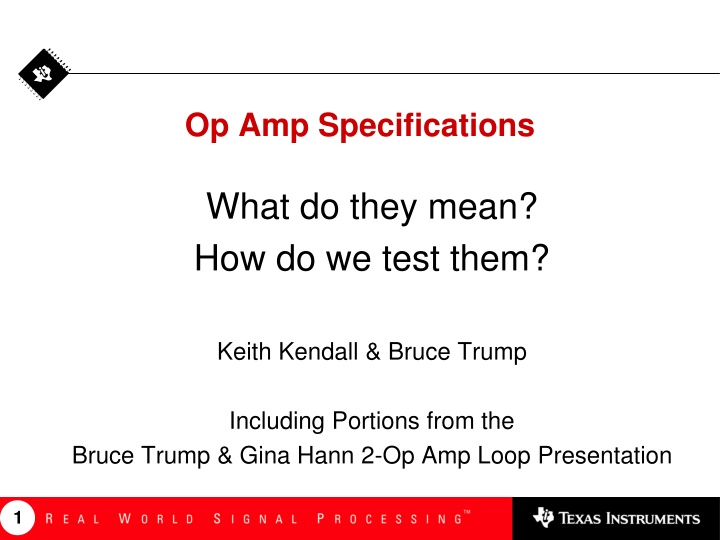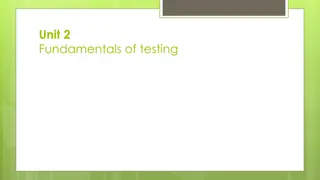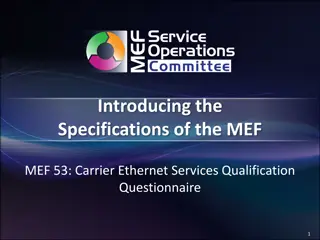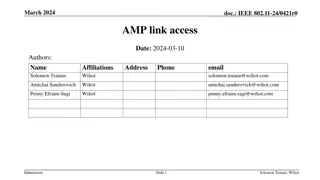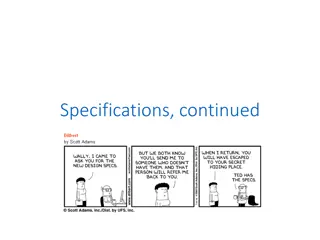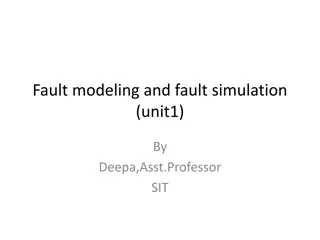Op-Amp Specifications and Testing
Op-amp specifications play a crucial role in determining the performance of operational amplifiers. This content delves into the meaning of specifications, how to test them, and the significance of parameters like open-loop gain, input offset, and more. Explore the testing methods, typical test limits, Gaussian distribution, yield per test at various sigmas, and production-worthy test limits for ensuring quality in op-amp designs.
Download Presentation

Please find below an Image/Link to download the presentation.
The content on the website is provided AS IS for your information and personal use only. It may not be sold, licensed, or shared on other websites without obtaining consent from the author.If you encounter any issues during the download, it is possible that the publisher has removed the file from their server.
You are allowed to download the files provided on this website for personal or commercial use, subject to the condition that they are used lawfully. All files are the property of their respective owners.
The content on the website is provided AS IS for your information and personal use only. It may not be sold, licensed, or shared on other websites without obtaining consent from the author.
E N D
Presentation Transcript
Op Amp Specifications What do they mean? How do we test them? Keith Kendall & Bruce Trump Including Portions from the Bruce Trump & Gina Hann 2-Op Amp Loop Presentation 1
Is he done yet? How we Choose specifications (the tests) Absolute Max Ratings Electrical Specifications Input Offset introducing the Two Op Amp Loop Open Loop Gain Output Voltage Swing Common Mode Rejection Ratio Vos revisited Power Supply Rejection Ratio Input Bias Current & Input Offset Current Another test circuit the False Summing Junction Life Test Thermal Drift Typical Curves System Generated Ordering Table the Package Option Addendum Your Turn 2
Typical Tests One Limit Upper and Lower Limit ISC Short Circuit Current CMRR(2) IO Output Current PSRR(2) IQ(1) Quiescent Current IB(2)Input Bias Current VOH Output High Voltage IOS(2)Input Offset Current VOL Output Low Voltage VOS(2)Input Offset Voltage AOL 1) Tested as two sided 2) We usually ignore the sign 3
Gaussian (or Normal) Distribution 18% 1 St Dev 3 St Dev 16% 14% 12% 10% 8% 6% 4% 2% 0% 65 70 75 80 85 90 95 100 105 110 115 120 125 130 135 140 145 68% within 1 standard deviation 99.7% within 3 standard deviations 4
Yield per test at various sigma We want a decent test yield. What limits do we need to choose to get an appropriate yield? Sigma One sided Two Sided 0 1 2 3 4 5 6 50.0% 84.1% 97.7% 99.9% 0.0% 68.3% 95.4% 99.7% 99.9968% 99.99997% 99.9999999% 99.9937% 99.99994% 99.9999998% 5
Production Worthy Test Limits Two Sided Testing Number of Parameters Tested 1 Sigma 68.3% 31.8% 14.8% 2 Sigma 95.4% 87.0% 79.2% 62.8% 31.2% 9.7% 0.9% 0.1% 3 Sigma 99.7% 99.2% 98.7% 97.3% 93.5% 87.4% 76.3% 66.7% 4 Sigma 99.99% 99.98% 99.97% 99.94% 99.84% 99.68% 99.37% 99.05% 5 Sigma 100.00% 100.00% 100.00% 100.00% 100.00% 100.00% 99.99% 99.99% 1 3 5 10 25 50 100 150 2.2% 0.0% 0.0% 0.0% 0.0% 6
Vos: What is it? +1mV DUT - + VOS 1mV 9
Vos Measurement simple method R1 999 R1 +2.5V 1000 VOS DUT = 1V - + VOS -2.5V 1mV 10
Vos is not a constant All specifications at TA = +25 C, RL = 2k connected to VS/2, VOUT = VS/2, and VCM = VS/2, unless otherwise noted. VOS 0 -2 -1 0 1 2 VOUT 11
Vos Measurement simple method R1 999 R1 +2.5V 1000 VOS DUT - + VOS -2.5V Includes error component due to Open-Loop Gain 12
The Two Op-Amp Loop 999R1 R1 +2.5V DUT - + VOS A2 1000 VOS -2.5V Loop controls DUT s output voltage at accurately defined potential. (0V) 13
Compensating the Two Op-Amp Loop OR 999R1 R1 DUT - + VOS A2 1000 VOS Inputs to both op amps are reversed. Feedback remains the same, but the loop is more easily compensated. 14
Open Loop Gain (AOL) AOL = VOUT / VOS 999 R1 R1 V+ VOUT DUT - + VOS A2 1000 VOS V- Max Vout + Modulate VOUT control signal between VMAX and VMIN VOUT - Min Vout 15
Open Loop Gain (AOL) Offset voltage rapidly increases as output tries to swing to rails. VOS V+ V- VOUT 16
Open Loop Gain (AOL) Open-Loop Gain is 1/Slope between end-points (in dB). VOS AOL = VOUT / VOS Max Vout VOUT Min Vout 17
Output Voltage Swing . . . 18
Common Mode Rejection Ratio Make loop control Vout to be at mid-supply. +2.5V R1 999R1 DUT - + VOS 1000 VOS A2 VOUT = Mid-Supply = 0V -2.5V 19
Common Mode Rejection Ratio 5.1V CMRR test part 1 of 2 CMRR = VOS / VCM R1 999R1 DUT - + VOS 1000 VOS A2 VOUT = Mid-Supply = 2.6V 0.1V 20
Common Mode Rejection Ratio CMRR test part 2 of 2 CMRR = VOS / VCM -0.1V R1 999R1 DUT - + VOS 1000 VOS VOUT = Mid-Supply = -2.6V -5.1V 21
Common Mode Rejection Ratio CMRR = VOS / VCM Transition Region Between two input stages VOS V+ V- VCM 22
Common Mode Rejection Ratio CMRR = VOS / VCM CMRR is slope of line between end-points (in dB). VOS V+ V- VCM Max CM Min CM 23
Common Mode Rejection Ratio CMRR = VOS / VCM Half Scale provides smaller (better) VCM/ VOS ratio VOS For devices with RR inputs we often provide a second CMRR spec for only the lower input stage. V+ V- VCM Max CM Min CM 24
Power Supply Rejection Ratio PSRR test part 1 of 2 PSRR = VOS / VS Min Supply 999 R1 R1 +1.85V DUT - + VOS A2 1000 VOS -0.85V 26
Power Supply Rejection Ratio PSRR test part 2 of 2 Max Supply PSRR = VOS / VS +3.25V 999 R1 R1 DUT - + VOS A2 1000 VOS -2.25V 27
Power Supply Rejection Ratio VOS vs. VS Soft breakdown at high voltage. Operation falling out at low voltage. 1 2 3 4 5 6 Total Supply Voltage 28
Power Supply Rejection Ratio At TA = +25 C, RL = 10kW connected to VS/2 and VOUT = VS/2, unless otherwise noted. 120 90 PSRR is slope over end-points. 60 30 0 PSRR = VOS / VS -30 -60 -90 -120 1 2 3 4 6 Min Vs Max Vs Total Supply Voltage 29
Input Bias Current Test Circuit Ccomp 10p R2 10k SW1 R4 1M ++ R3 100 - Vos*100 SW2 - ++ R5 1M DUT !OPAMP !OPAMP IB = Vos / 1M 30
Input Bias Current Test Circuit Charge accumulation Ccomp 10p V R2 10k SW1 C1 1n 20 ++ 15 R3 100 - Vos*100 SW2 - 10 ++ C2 1n DUT !OPAMP 5 !OPAMP 0 0 5 10 15 20 25 30 35 40 (ms) TIME IB = C*dVc/dt Example: IB = 1nF*5mV/10ms = 50pA 31
Input Offset Current, IOS Input Offset Current is the difference between the two input bias currents. IOS = (IB+) - (IB-) 32
The False Summing Junction Vout = 101 * Vos R1 100k R2 100k Vref R3 10k DUT !OPAMP - R4 100 ++ Vref is based on the desired output voltage Vout = 101 * Vos when Vref is ground 33
Life Test Different groups Different criteria Allow a shift of <10% of the data sheet range Allow 50% of the data sheet range for Vos and certain others 1.5 1.0 For Example a device with a Vos specification limit of 1mV 0.5 0 -0.5 -1.0 -1.5 34
Thermal Drift Example Drift Measurement VOS DUT -40 C 25 C 85 C 5 A B C A -3.2 3 2.5 mV 4 3 B -2.7 3.5 4 mV 2 1 Vos (mV) C -3.7 0 3 mV 0 -1 -2 Drift Calculation -3 -4 A = (6.2 + 0.5) / 125 = 0.05mV/ C -5 -40 -20 0 20 40 60 80 Temperature ( C) B = (6.2 + 0.5) / 125 = 0.05mV/ C C = (3.7 + 3.0) / 125 = 0.05mV/ C Drift = ( |slope1| + |slope2| ) / TempRange 35
The End Your Turn to talk 40
